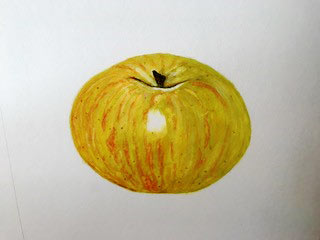Thomas Jefferson’s favorite cider apple was the Taliaferro, pronounced “Tolliver.” He acclaimed it “the best cyder apple existing,” producing “unquestionably the finest cyder we have ever known, and more like wine than any other liquor I have ever tasted which was not wine.” Unprecedented quantities of grafted trees were planted in the South Orchard at Monticello, cider was served with beer at meals, and the March bottling of some 120 gallons of fermented cider was part of the yearly work routine. Jefferson wrote how the initial apple seedling was discovered by Major Richard Taliaferro in the mid-eighteenth century, growing near Williamsburg in a “large old field where the seed had probably been dropped by some bird.” Taliaferro made and then shared cider from the apple, and “in the estimation of every one who tasted it [it] was the finest they had ever seen.” Taliaferro planted a grafted orchard, as did Jefferson’s law school mentor, George Wythe, Taliaferro’s brother-in-law.

Although Jefferson treasured the apple and provided a full account of its discovery, he never described the qualities of the fruit itself, such as size, shape, or color. Up until now, the only early fruit growers or pomologists to provide detailed features of the Taliaferro, particularly William Kenrick of Boston and William Coxe of New Jersey, offered descriptions that were contradictory, vague, and confusing. You can’t find something if you don’t know what it is. With the recent revival of interest in heritage apples and craft ciders the much celebrated Taliaferro cider apple has achieved elevated status as a lost “founding apple.” I myself have written, “the enigma of the lost Taliaferro has elevated its stature among historic apple hunters to almost mythic qualities, and handfuls of potential candidates . . . reappear like migratory birds every season.” Apple hunters have brought forth specimens named Nelson County Crab, Red Coat, and Highland County that they have claimed were the lost Taliaferro. I concluded in The Fruits and Fruit Trees of Monticello (1988) that Jefferson’s mystery apple will never be found “unless an undiscovered pomological description miraculously appears.”
The quest for the Taliaferro has recently been altered dramatically by research undertaken by Susan Walker, Chief Magistrate Judge in the U.S. District Court of Alabama. Walker became captivated by the mystery of the Taliaferro after growing historic apples at her Alabama farm. She composed an eighty-four-page monograph, “Of Lost Letters and Forgotten Fruit: Timothy Pickering, John Taliaferro, and the Mystery Apple of Monticello,” exploring all dimensions of the apple’s documentary history. These include an examination of the potential sites where the apple was initially grown near Williamsburg, the history of who grew and sold the Taliaferro in the nineteenth century, and fascinating revelations about why William Coxe, author of the first distinctly American book on horticulture, A View Toward the Cultivation of Fruit Trees (1817), incorrectly described the Taliaferro by confusing it with another Virginia apple. The ultimate significance of the monograph, a revelation that might lead to the actual discovery of the apple itself, is the Walker description of its qualities, pieced together through some remarkable documentary sleuthing.
The new description of the Taliaferro is based, primarily, on four unpublished letters in 1816 and 1817 between the Congressman John Taliaferro of Fredericksburg, Virginia, a distant relative of Richard Taliaferro, and U.S. Senator Timothy Pickering of Massachusetts. In addition, Walker found a confirming description in the 1833-34 Catalogue of the William Robert Prince nursery in Flushing, New York. The newly unveiled Taliaferro is medium-sized, flat or oblate (wider than it is high), “a bright straw color, tinged … with a reddish blush or faint streaks of red, similar to the most delicate red shades in a rainbow.” The fruit also exhibits “an exquisite flavor” at maturity when eaten out of hand, and is abundantly juicy. The resultant cider would meet Jefferson’s criteria to be “more like wine than any liquor I have ever tasted which was not wine.” Judge Walker dug deep in effectively defining what was “straw-colored” in the eighteenth century, and how a “flat” apple is distinctive in the apple vernacular. She also composed a watercolor based on these documentary sources to aid future apple hunters seeking the prized Taliaferro itself.
Historian Annette Gordon-Reed utilized her legal background to brilliantly solve the twisted puzzle of Thomas Jefferson’s relationship with Sally Hemings. Similarly, Susan Walker’s research demonstrates uncanny lawyerly logic, solid and exhausting scholarship, and unrelenting persistence in following all the convoluted leads and then blowing away the various documentary blockades that confounded many of us in our search for the Taliaferro. If Judge Walker’s revelatory study should prove fruitless, for example if the Taliaferro is indeed extinct, her monograph nonetheless provides a model for plant hunters of all sorts. Susan is hopeful of publishing her essay, and is presently abridging the article for a suitable scholarly journal.
~Originally appeared in the Twinleaf Journal Online, by Peter J. Hatch. Hatch is Monticello’s director emeritus of gardens and grounds, is the author of: The Fruits and Fruits Trees of Monticello (2007) and ‘A Rich Spot of Earth’ Thomas Jefferson’s Revolutionary Garden at Monticello (2012).
Hatch, Peter. "Monticello's Mystery Plants," Twinleaf [Gardening Newsletter at Monticello], January 2004.
ADDRESS:
1050 Monticello Loop
Charlottesville, VA 22902
GENERAL INFORMATION:
(434) 984-9800
